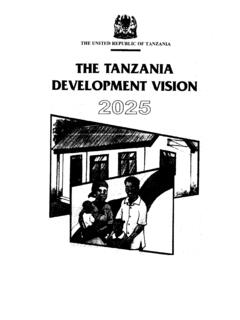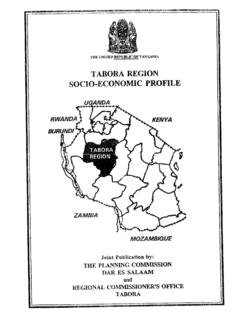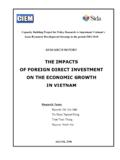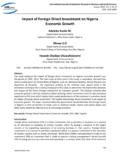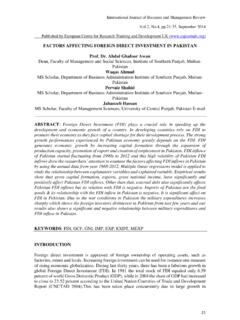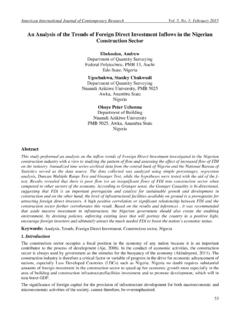Transcription of The Impact of Globalisation on Tanzania’s Labour Market ...
1 The Impact of Globalisation on tanzania s Labour Market : Evidence from the Manufacturing Sector By Beatrice Kalinda Mkenda, email: A paper prepared for a Policy Dialogue for Accelerating Growth and Poverty Reduction in tanzania , held at the Conference hall, ESRF, on July 28th, 2005. Globalisation and Employment in tanzania s Manufacturing Sector 2 List of Abbreviations COMESA Common Market for Eastern and Southern Africa CSAE Centre for the Study of African Economies EAC East African Community ERP Economic Recovery Programme ESAP Economic and Social Action Programme ESRF Economic and Social Research Foundation FDI Foreign Direct Investment GDP Gross Domestic Product ILFS Integrated Labour Force Survey IMF International Monetary Fund IPC Investment Promotion Centre ITC International Trade Centre IUOE International Union of Operating Engineers NBER National Bureau of Economic Research NOTU
2 National Organisation of Trade Unions OGL Open General License QRs Quantitative Restrictions RPED Regional Programme on Enterprise Development TIC tanzania Investment Centre TMES tanzania Manufacturing Enterprise Survey TTCL tanzania Telecommunications Company Limited UNCTAD United Nations Conference on Trade and Development UNIDO United Nations Industrial Development Organisation URT United Republic of tanzania VAT Value Added Tax Globalisation and Employment in tanzania s Manufacturing Sector 3 1. Introduction This paper derives from a study that was commissioned by the ESRF, under the Globalisation and East Africa Project . The study investigated the ways in which Globalisation , specifically, the economic reforms pursued by the Tanzanian government and the presence of foreign and exporting firms, have impacted on the Labour Market .
3 The aim of this paper is to present the key findings from that study, as well as to discuss some emerging policy issues. As such, this paper does not contain detailed discussions of the theoretical basis and methodology of the study. Interested readers can refer to the research report for such The key findings that I discuss from the research report pertain to the following questions: What has been the Impact of trade liberalisation, investment reforms and privatisation, and public sector reforms on employment? Do foreign-owned and exporting firms pay higher wages than locally owned firms? Do foreign-owned and exporting firms employ more workers than locally owned firms? To what extent do workers feel secure in their jobs?
4 2. The Context The Tanzanian economy has over the years, witnessed a rapid integration of its economy to the rest of the world, through a process widely called Globalisation . Globalisation can be defined as the process of increasing economic, political, social and cultural integration, whereby influences beyond national boundaries have a crucial Impact constraining and influencing all aspects of national well-being. The interaction is seen in form of increased flow of goods, ideas and services, increased flow of capital, and migration of people (see ESRF, 2002). A number of factors have been driving the Globalisation process. These are technological advances, trade and investment liberalisation, internationalisation of business activity, and human migration (ESRF, 2002; 1 Mkenda (2005a).)
5 Globalisation and Employment in tanzania s Manufacturing Sector 4 Stiglitz, 2002). For the purpose of this study, we will focus on economic Globalisation , defined as the closer integration of countries through trade and capital movements, aided by liberalisation policies. tanzania s integration with the rest of the world can be seen through one of the key economic indicators of Globalisation , which is capital Figure A1 in the appendix shows an increasing trend in the amount of FDI inflows and inward stock to tanzania from 1970 to 2003. The figure illustrates that tanzania has attracted an increasing amount of foreign investment, although at a global level, the amount is a small share. Like other developing countries, the level of integration of the Tanzanian economy with the rest of the world has been aided by the structural adjustment policies.
6 The Tanzanian government has been undertaking structural adjustment reforms under the tutelage of the IMF/World Bank since the mid 1980s, although the tempo of liberalisation and structural adjustment only picked up from the mid 1990s. The reforms that have been undertaken such as trade liberalisation, privatisation of state-owned enterprises, public sector reforms and encouragement of foreign direct investment (FDI) by liberalisation of investment laws and markets, have impacted on the Labour Market in terms of employment and earnings. An understanding of the ways in which employment and earnings have been affected is therefore important. This is because the extent to which people are able to generate income from employment has implications on welfare in general and poverty in particular.
7 3. The Impact of Trade Liberalisation, Investment Reforms and Privatisation, and Public Sector Reforms on Employment What has been the Impact of trade liberalisation, investment reforms and privatisation, and public sector reforms on employment? 2 Other indicators are; the amount of aid inflows, the percentage of trade in GDP, the convergence of domestic prices and world prices, the number of international tourists, incoming and outgoing international telephone calls, transfer payments and receipts, the number of Internet users, Internet hosts, and secure servers (see Foreign Policy Magazine, 2001, , and Mkenda, 2002b).
8 Globalisation and Employment in tanzania s Manufacturing Sector Trade Liberalisation3 The main trade reforms that tanzania has undertaken are tabulated in Table A1 in the appendix. The exchange rate reforms dealt with the over-valued tanzania Shilling which constrained the competitiveness of exports. Trade reform is also evident from the measures undertaken on quantitative restrictions (QRs) on imported goods, improving incentives to exporters, such as duty drawback schemes, removal of export duties, and eliminating the need to obtain licenses. The structure of tariffs was rationalised and their levels reduced, as the trend shows in Table 1. Table 1: Average Tariff Rates for tanzania , Selected Years, 1982-99 1982 1986 1987 1988 1989 1990 1992 1993 1994 1995 1996 1997 1999 Unweighted (%) - Source: World Bank, (2001), International Trade and Development Database.
9 For tanzania , the textile sector felt the brunt of trade liberalisation. Although the sector faced numerous problems over the years including mismanagement, poor and out-dated technology, high operating costs such as high power tariffs, it also faced competition from sub-standard imports due to low import tariffs. The sub-standard imports in turn led to Labour redundancies as textile firms closed, and capacities lay idle. For example, in the early 1980s at the height of its operation, there were 35 textile firms, which dropped to just 2 in 1996. However, currently, a number of textile firms have been privatized, and have resumed operation after modernizing their mills, and also, new mills have been established (ITC, 2005).
10 Investment Reforms and Privatisation After years of following a socialist model of economic development that was ushered in through the Arusha Declaration, the government of tanzania embarked on Market reforms from the mid 1980s. Although the reforms proceeded slowly to begin with, there was a marked improvement in the pace in the 1990s. Part of the reforms were those pertaining to investment policies so as to attract foreign investment. The process of reforms regarding investment began with an investment code that was introduced in June 1990, though not successful due to a weak response from the private sector. Then the New Investment Policy of tanzania was ushered in 1996, which led to the Investment Act of 1997.
